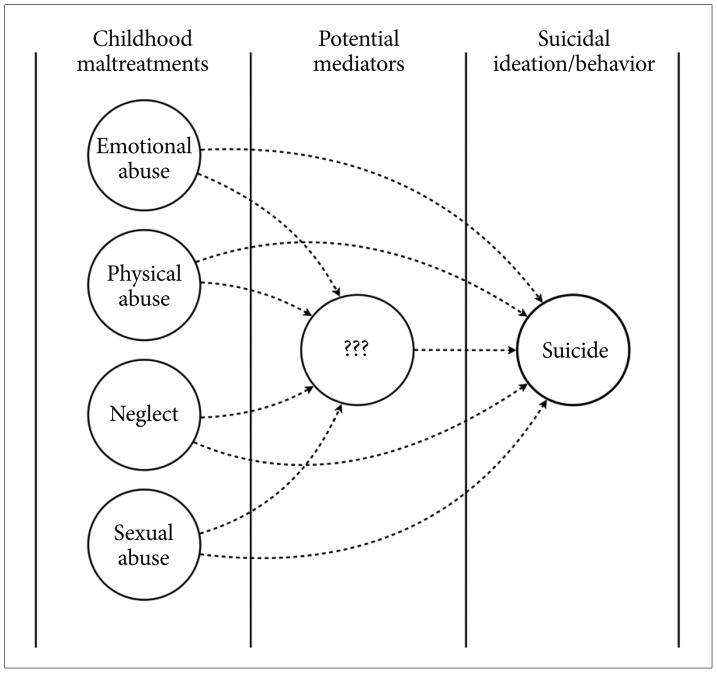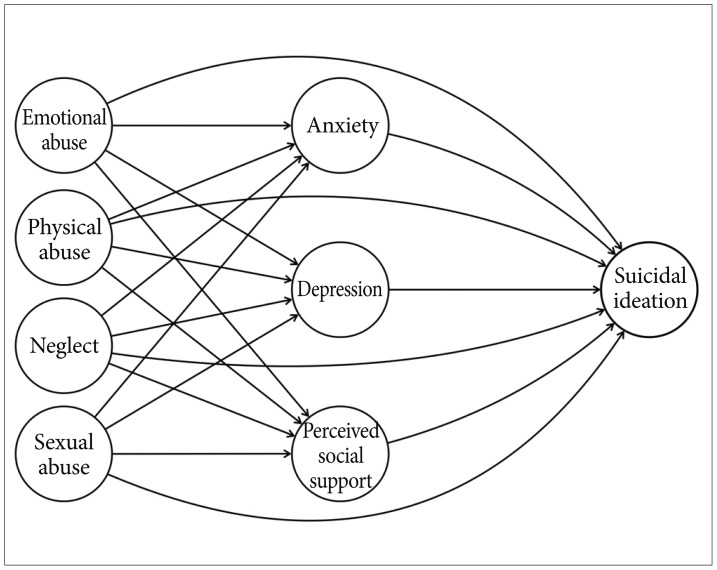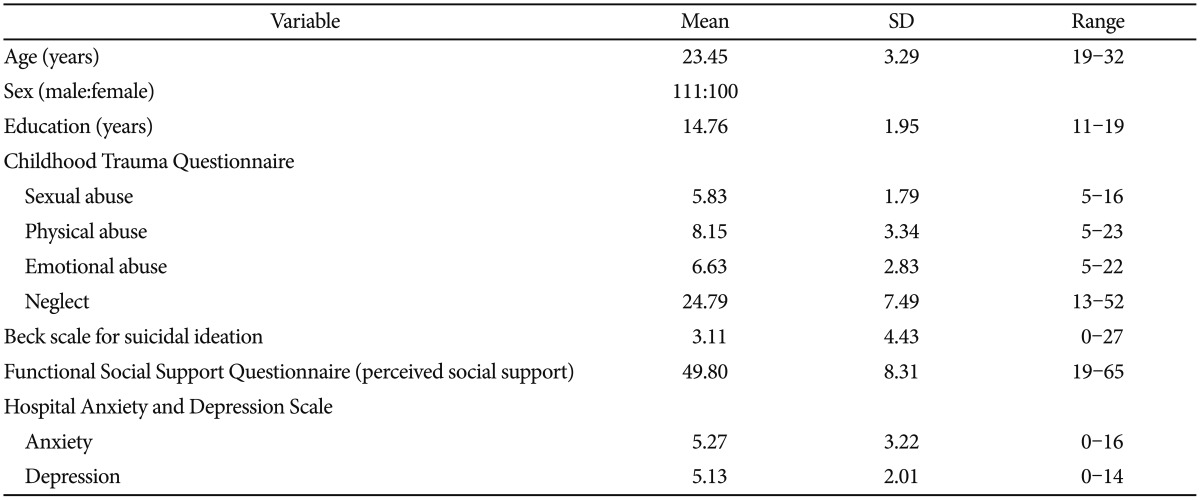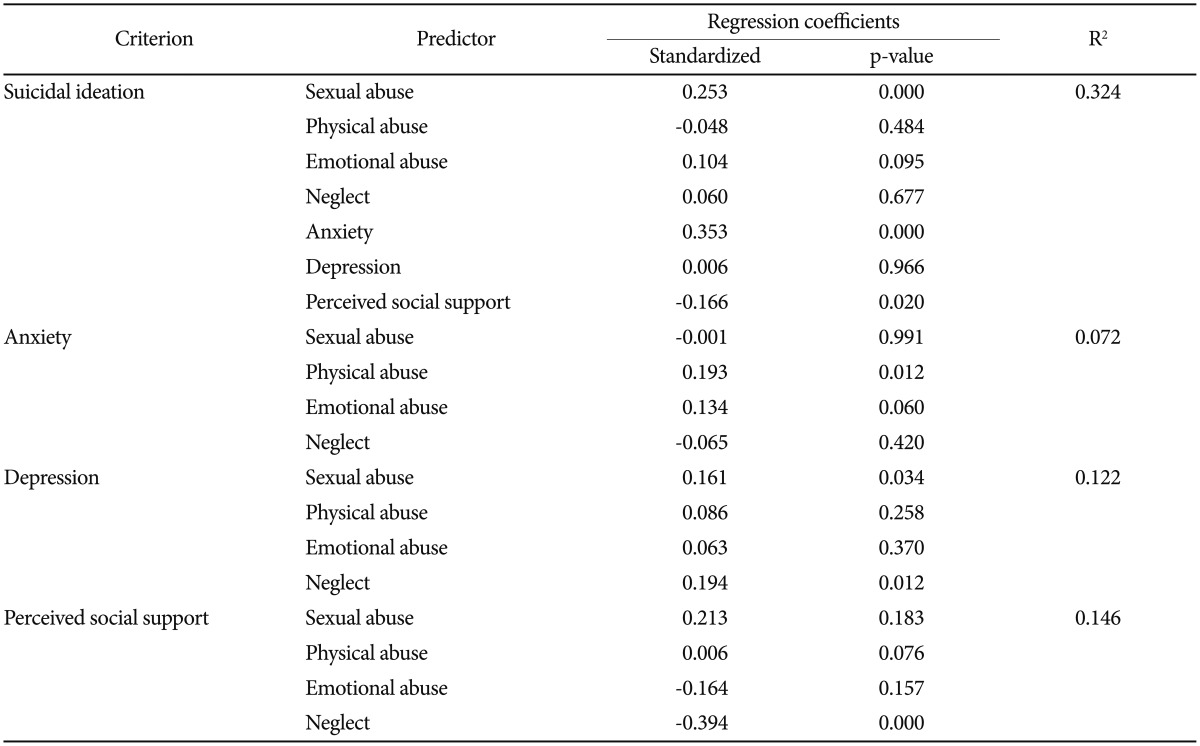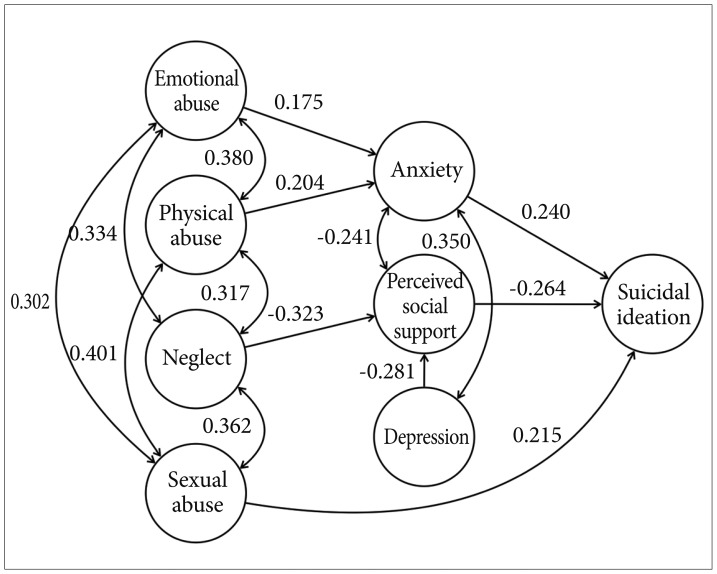The Relationship between Childhood Trauma and Suicidal Ideation: Role of Maltreatment and Potential Mediators
Article information
Abstract
Objective
Childhood trauma is recognized as an important risk factor in suicidal ideation, however it is not fully understood how the different types of childhood maltreatment influence suicidal ideation nor what variables mediate the relationship between childhood trauma and suicidal ideation. This study examined the path from childhood trauma to suicidal ideation, including potential mediators.
Methods
A sample of 211 healthy adults completed the Childhood Trauma Questionnaire (CTQ), Beck scale for Suicidal Ideation (BSI), Functional Social Support Questionnaire (FSSQ) and Hospital Anxiety and Depression Scale (HADS). Path analysis was used to investigate the relationship among study variables.
Results
Of the several types of childhood maltreatment we considered, only childhood sexual abuse directly predicted suicidal ideation (β=0.215, p=0.001). Childhood physical abuse (β=0.049, 95% confidence interval: 0.011–0.109) and childhood emotional abuse (β=0.042, 95% confidence interval: 0.001–0.107) indirectly predicted suicidal ideation through their association with anxiety. Childhood neglect indirectly predicted suicidal ideation through association with perceived social support (β=0.085, 95% confidence interval: 0.041–0.154).
Conclusion
Our results confirmed that childhood sexual abuse is a strong predictor of suicidal ideation. Perceived social support mediated the relationship between suicidal ideation and neglect. Anxiety fully mediated the relationship between suicidal ideation and both physical abuse and emotional abuse. Interventions to reduce suicidal ideation among survivors of childhood trauma should focus on anxiety symptoms and attempt to increase their social support.
INTRODUCTION
Suicide is a multifaceted phenomenon with multiple risk factors including psychosocial,1 neurobiological2 and psycho-pathological factors.3 It is recognized that childhood trauma can lead to suicidal ideation and behavior.456 Although childhood maltreatment predicts suicidal ideation and behavior across the lifespan, the precise role of particular types of childhood maltreatment and the mediators of the relationship between childhood maltreatment and suicide have not been fully investigated (Figure 1).57
Childhood maltreatment is an umbrella terms encompassing childhood sexual, physical and emotional abuse and neglect.5 Childhood sexual abuse is typically defined as unwanted, inappropriate sexual activity with perpetrator (e.g., verbal sexual harassment, exhibitionism).8 Physical abuse is defined as any intentional act which have potential to or do cause injury or trauma by an older person.9 Emotional abuse, also referred to as psychological abuse is defined as behavior that causes psychological trauma or stress. It can include verbal assaults, any threatening, demeaning, terrorizing or humiliating remarks.10 Finally, neglect is defined as a deficit in meeting a child's basic physical needs (i.e., food, shelter, safety) or psychological needs (i.e., encouragement, belongingness, warmth, love and support).11 Childhood sexual121314 and physical abuse71516 have been known to be linked to suicidal ideation. It has been suggested that research into the relationship between childhood maltreatment and suicide has focused disproportionately on sexual and physical abuse.7 There have been relatively few studies examining the relationship between suicide and childhood emotional abuse and neglect. A recent systematic review noted that only 8 studies have considered the relationship between suicide and emotional abuse and neglect, compared with 52 studies considering sexual abuse and 24 considering physical abuse.5
Recent research has suggested that the relationship between childhood maltreatment and suicidal ideation may be mediated by other important variables,5 and that targeting such mediators is crucial to effective mental health interventions to reduce suicidal risk. There have, however, been only a few studies examining potential mediators such as psychiatric symptoms and psychosocial factors.71718 Felzen17 found that interpersonal problems mediated the relationship between childhood maltreatment and suicidal behavior. Miller, Adams, Esposito-Smythers, Thompson Proctor18 reported that parental relationships, friendships and depression mediated the relationship between childhood maltreatment and suicidal ideation. High perceived social support has been reported to be protective against suicide.19 Several studies have indicated that childhood trauma is associated with depression and anxiety in adulthood.202122 It has also been suggested that anxiety and depression mediate the relationship between childhood trauma and suicide.13
With these findings in mind, the aim of this study was to explore the relationship between childhood maltreatment and suicidal ideation in a community sample. We hypothesized that 1) childhood sexual, physical and emotional abuse and childhood neglect would be directly or indirectly associated with an increased risk of suicidal ideation in adulthood, 2) perceived social support, depression and anxiety would partially mediate the relationship between suicidal ideation and these forms of childhood maltreatment. We investigated whether the established relationship between childhood maltreatment and suicidal ideation could be explained by a model that posits perceived social support, depression and anxiety as mediators. The hypothesized model is shown in Figure 2.
METHODS
Participants
The sample consisted of 211 healthy adults aged 20 to 32 years old (47.39% women). Subjects were screened by the Structured Clinical Interview for the Diagnostic and Statistical Manual of Mental Disorders, Fourth Edition in order to exclude current and/or lifetime Axis I23 and II disorders.24 Subjects with organic brain disease, a hearing problem, or family history of a mental disorder were also excluded. All subjects were no smoking, and right handed. The study protocol was approved by the Institutional Review Board of Inje University Ilsan Paik Hospital.
Measures
Childhood emotional abuse and neglect
The Childhood Trauma Questionnaire (CTQ)25 was used to measure childhood maltreatment. The CTQ (28 items) comprises four subscales: sexual abuse (5 items; e.g., was molested, was touched sexually), physical abuse (5 items; e.g., hit hard enough to leave bruises, hit badly enough to be noticed), emotional abuse (5 items; e.g., felt hated by family, family said hurtful things), and neglect (13 items; e.g., made to feel important, got taken to doctor). Items are rated using a 5-point Likert-type scale. In addition, It has been suggested that a cutoff score of 9 on the sexual abuse subscale and 12 on the physical abuse subscale in psychiatric samples.25 All the subscales have been shown to have good internal consistency and reliability (α=0.77–0.83 in Korean samples).26
Suicidal ideation
The Beck scale for Suicidal Ideation (BSI) Beck, Steer Ranieri27 was used to assess suicidal ideation. It has good internal consistency (α=0.74) and moderately high correlations with other measures of suicidal ideation and hopelessness in Korean samples.28
Perceived social support
The Functional Social Support Questionnaire (FSSQ)29 was used to assess perceived social support. It is a 13-item self-report questionnaire which has excellent internal consistency (α=0.89) in Korean samples.30
Anxiety and depression
The Hospital Anxiety and Depression Scale (HADS) Zigmond Snaith31 was used to measure anxiety and depression. The HADS consists of 2 subscales: anxiety (7 items) and depression (7 items). Both subscales have been demonstrated to have excellent internal consistency (both α=0.89) in a Korean sample.32
Data analysis
We evaluated our model of suicidal ideation using path analysis conducted with Mplus. Path analysis is a statistical method for calculating the strength of relationships among constructs.33 Path analysis has two over correlation analyses: 1) the ability to assess several relationships simultaneously and 2) the ability to specify the directionality of relationships. In path analysis there are two levels of analysis, relating to the significance of individual paths between variables and the overall fit of the model to the data. Overall model fit is evaluated using several indices: 1) the Root Mean Squared Error of Approximation (RMSEA; conventional criteria are good fit: ≤0.05, adequate fit: ≤0.08), 2) the Comparative Fit Index (CFI; adequate fit: ≥0.95) and 3) the Tucker-Lewis Index(TLI; adequate fit: >0.95).34 The bootstrap procedure described by Preacher Hayes35 was used to estimate the size of the indirect effects (n=5000 resamples). Other statistical variables were calculated using SPSS.
RESULTS
The demographic and clinical profile of the sample is presented in Table 1. Correlation analyses demonstrated that associations between variables were in the expected direction (Table 2). Path analysis showed that the hypothesized model (Figure 2) was a poor fit to the data (RMSEA=0.167; CFI=0.889; TLI= 0.749). The parameter estimates were evaluated, and the results are shown in Table 3.
On the basis of these results we trimmed our hypothesized model. In accordance with the modification index we removed insignificant paths and added a path from depression to perceived social support (Figure 3). Path analysis indicated that the trimmed model was a good fit to the data (RMSEA=0.044; CFI=0.969; TLI=0.958). The results of path analysis of the trimmed model are presented in Table 4 and Figure 3. The path analysis revealed that sexual abuse and anxiety were positive predictors of suicidal ideation (β=0.215, p=0.001; β=0.240, p<0.000 respectively) whilst perceived social support was a negative predictor (β=-0.264, p<0.000). The results also showed that perceived social support fully mediated the relationship between suicidal ideation and neglect (β=0.085, 95% confidence interval: 0.041–0.154) and depression (β=0.074, 95% confidence interval: 0.030–0.143). Anxiety fully mediated the relationship between suicidal ideation and physical abuse (β=0.049, 95% confidence interval: 0.011–0.109) and emotional abuse (β=0.042, 95% confidence interval: 0.001–0.107).
DISCUSSION
This study investigated the pathway from different types of childhood maltreatment to suicidal ideation and explored potential mediators of the relationship. Of several types of childhood maltreatment investigated, only childhood sexual abuse directly predicted suicidal ideation. Childhood physical and emotional abuse indirectly predicted suicidal ideation through their association with anxiety. Childhood neglect indirectly predicted suicidal ideation through its association with perceived social support.
Consistent with previous research,121314 our findings showed that childhood sexual abuse is directly associated with suicidal ideation. Childhood sexual abuse was still associated with suicidal ideation after controlling for the effects of other forms of childhood maltreatment; this is not surprising because childhood sexual abuse is recognized as form of trauma which has serious, long-term psychological sequelae such as sexual disturbance, depression, anxiety, fear, anger and suicidal ideation in later adulthood.3637 It has also been suggested that childhood sexual abuse is associated with medical problems such as chronic pelvic pain38 and even abnormalities of brain developments.3940 These results corroborate previous research suggesting that childhood sexual abuse is a serious risk factor for suicide in adulthood.
Unlike previous studies7151641 we did not find that childhood physical or emotional abuse and childhood neglect were direct predictors of suicidal ideation. We did, however, find indirect positive associations between suicidal ideation and childhood physical or emotional abuse which were mediated by anxiety. We also found an indirect positive association between childhood neglect and suicidal ideation which was mediated by perceived lack of social support.
Anxiety has been identified as an important risk factor for suicide in adults. Several studies have suggested that anxiety disorders are associated with an increased risk of suicide.424344 A large population-based longitudinal study showed that after adjusting for sociodemographic factors and the presence of all other mental disorders (except anxiety disorder), there were significant associations between suicidal ideation and presence of anxiety disorders. The same study found that comorbid anxiety disorder increased the risk of suicide attempts relative to the risk associated with mood disorder alone.44 A number of studies have reported that anxiety symptoms are associated with suicide.4546 Some previous studies have reported that childhood physical and emotional abuse and childhood neglect are directly related to suicidal ideation, whereas some studies have reported that childhood physical and emotional abuse are associated with anxiety.474849 Recently it was reported that among women with postpartum depression, having frequent thoughts about self-harm was associated with childhood physical abuse and anxiety symptom.50 In light of these findings our results suggest that anxiety plays an important role as a mediator of the relationship between childhood maltreatment and suicidal ideation.
It is not surprising that perceived social support fully mediated the relationship between childhood neglect and suicidal ideation because both perceived social support and neglect relate to lack of affection and support from others. High perceived social support has been recognized as strongly protective against suicide.5152 In addition, the mediating role of perceived social support was repeatedly reported in the path analysis to predict the suicide.5354 It has also been shown that perceived social support mediates the relationship between childhood maltreatment and various adverse outcomes.5556 Interestingly, depression did not directly predict suicidal ideation. Instead, depression indirectly predicted suicidal ideation through perceived social support. There have been several studies that depression is related to suicidal ideation, however, recent study showed that depression did not predict suicidal ideation directly, predicted suicidal ideation through interpersonal variables such as belongingness.57 The results of our study suggest that anxiety and perceived social are important mediators of the relationship between childhood maltreatment and suicidal ideation and hence should be considered important targets for interventions to reduce suicide risk.
There are some limitations to this study. First, as it is based on a cross-sectional design we cannot confirm causal relationships between variables; further longitudinal research would be needed to do so. Second, our suggested model might be suitable for only suicide ideation because suicide attempt and ideation are different. It might be useful to test the model in a sample of individuals with a history of attempted suicide. Lastly, the participants in this study were healthy individuals without any history of psychiatric disorder; it is therefore important to replicate our findings in clinical samples. And also our data of childhood maltreatment, depression, anxiety and suicidal ideation score were positively skewed. However, we conducted square root transformation on theses variable to bring it closer to normal distribution, and analyzed the transformed and original data both. It was found that the pattern of results did not meaningfully differ.
Despite these limitations this study has demonstrated the utility of a model of the paths between childhood maltreatment and suicidal ideation in adults. Our results suggest that sexual abuse is the form of childhood maltreatment most strongly associated with suicide risk, and that anxiety and social support are important mediators of the relationship between childhood maltreatment and suicidal ideation. We therefore recommend that clinicians should screen patients for anxiety and lack of social support in order to identify those at greater risk of suicidal ideation.
Acknowledgments
This work was supported by a grant from the Korea Science and Engineering Foundation (KOSEF), funded by the Korean government (NRF-2015M3C7A1028252).
